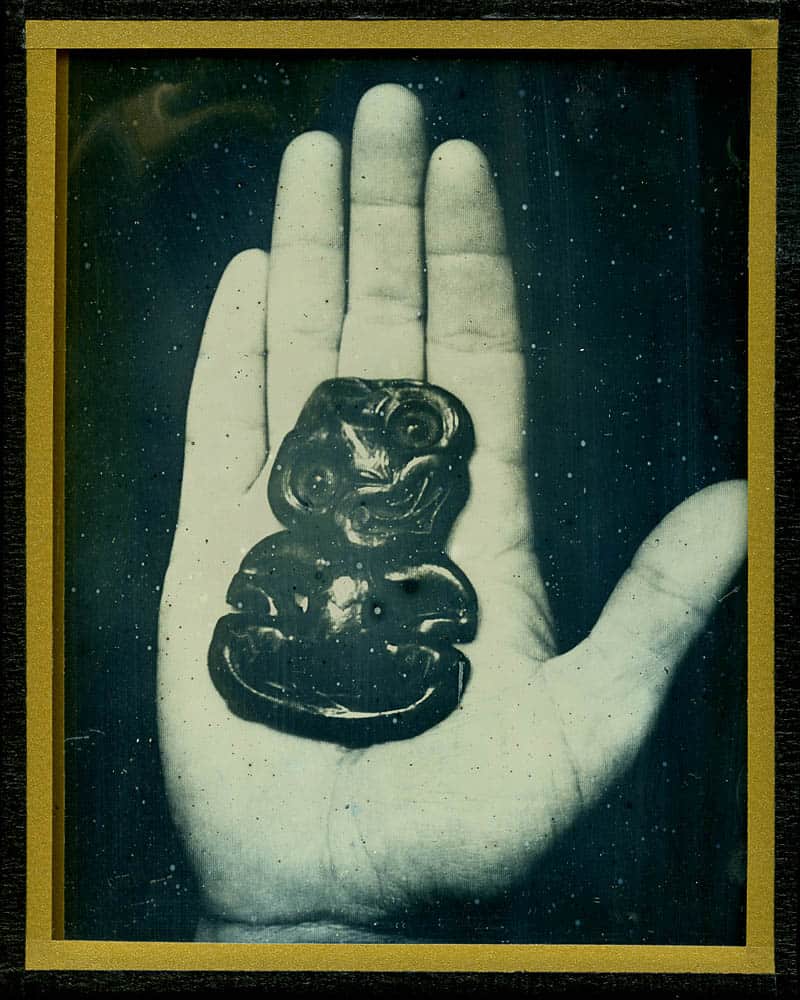- James Tylor, Te Moana Nui installation photograph at Monash Galley of Art, Melbourne, Australia 2
- James Tylor, Hawaiki (Navigating time and space) 2017, Daguerreotype, 4x5in
- James Tylor, Pakanga (The Price of Land) 2017, Daguerreotype, 4x5in
- James Tylor, Tā moko (More than skin deep), 2017, Daguerreotype, 4x5in
- James Tylor, Whakapapa- Holding the ancestors 2017, Daguerreotype, 4x5in
While Garland focuses primarily on objects, we do like to highlight representational practices like photographs that involve craft and materials. We featured his torn photograph Aotearoa my Hawaiki in the online exhibition Second Home. A recent series uses the concept of Te Moana Nui to frame a series of works that were exhibited at the Samstag Museum in Adelaide and Monash Gallery of Art in Melbourne. Tylor masters the Daguerreotype method that was used to capture the first photographic images of Indigenous peoples in Moana.
Artist Statement
Te Moana Nui is a daguerreotype series that navigates through the cultural history of the Pacific Ocean. Te Moana Nui is the most accepted Polynesian name for the region of Pacific Ocean and in Māori language it is extended slightly to Te Moana Nui o Kiwa. Polynesian people have been exploring, migrating and living throughout the Pacific Ocean for more than 5000 years.
Polynesian people have developed rich and diverse cultural customs from travelling, trading and living in the Pacific. Polynesian migration has stretched from the Philippines in Asia to trading in Chile, South America. They have also settled as far as Aotearoa (New Zealand) in the South, Norfolk Island in the West, Rapa Nui (Easter Island) in the east and Hawai’i in the North of the Pacific Ocean.
The history of different cultural changes that have taken place in the Pacific region has been greatly influenced by migration, war and trade. Polynesian people have not just traded items such as food and cultural material, but also language, beliefs, ideas and customs.
In recent years, Polynesian people and culture have been greatly affected by the colonisation of the Pacific by multiple European empires, including the British, French, Spanish, Portuguese, Germans and Americans. European colonisation has changed many aspects of Polynesian society, such as language, religion, food, migration and trade.
In Te Moana Nui: Navigating time and space, I have drawn on my Māori heritage to focus on the Polynesian cultural history of Aotearoa and how this has been influenced by migration, trade and conflict in the Pacific region of Te Moana Nui
Biography
James Tylor (Possum) was born in Mildura, Victoria. He spent his childhood in Menindee in far west New South Wales, and then moved to Kununurra and Derby in the Kimberley region of Western Australia in his adolescent years. From 2003 to 2008, James trained and worked as a carpenter in Australia and Denmark. In 2011 he completed a bachelor of Visual Arts (Photography) at the South Australian School of Art in Adelaide and in 2012 he completed Honours in Fine Arts (Photography) at the Tasmanian School of Art in Hobart. He returned to Adelaide in 2013 and completed a Masters in Visual Art (Photography) at the South Australian School of Art. James currently lives and works in Adelaide.
James’ artistic practice examines concepts around cultural identity in Australian contemporary society and social history. He explores Australian cultural representations through his multi-cultural heritage, which comprises Nunga (Kaurna), Māori (Te Arawa) and European (English, Scottish, Irish, Dutch, Iberian and Norwegian) Australian ancestry. James’ work focuses largely on the 19th-century history of Australia and its continual effect on present-day issues surrounding cultural identity in Australia.
James’ artistic practice specialises in experimental and historical photographic processes. He uses a hybrid of analogue and digital photographic techniques to create contemporary artworks that reference Australian society and history. The processes he employs are the physical manipulation of digital photographic printing, such as the manual hand-colouring of digital prints or the application of physical interventions to the surfaces of digital prints. James also uses the historical 19th-century photographic process of the Becquerel Daguerreotype with the aid of modern technology to create new and contemporary Daguerreotypes. Photography was historically used to document Aboriginal culture and the European colonisation of Australia. James is interested in these unique photographic processes to re-contextualise the representation of Australian society and history.






